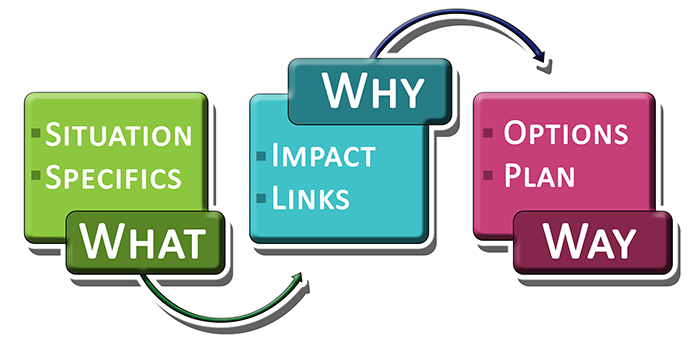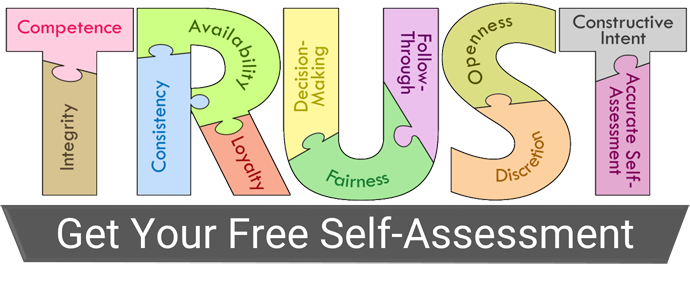Don’t Underestimate the Value of Trust in an Organization
Why are some workplaces so much more laidback yet productive than others? What is it that makes teams hum and employees engaged? How can some organizations retain employees and attract superstars with seemingly little effort? All these questions can be answered by understanding the value of trust in an organization.
When people throughout an organization trust the organization, the management team, and their colleagues… when they feel trusted… and when that trust creates effortless synergies and unleashes innovative thinking… people feel a sense of pride and belonging. Trust is like superglue that holds the entire operation together through thick and thin.
Measuring the Value of Trust in an Organization
The impact of two-way trust that’s consistently displayed is described well in the Covey work known as The Speed of Trust. The over-arching conclusion of that research is that “trust is a hard-nosed business asset which can deliver quantifiable economic value.”
When trust is high, both time required for task completion and costs go down. When trust is low, time required and costs increase. To save time and money, organizations should focus on building and maintaining a culture of high trust.
You’ll be able to measure the costs associated with mistrust in your organization when you:
- Calculate the cost of time wasted in meetings due to mistrust. If people are checking on one another’s findings, requiring over-representation vs. sending a single delegate to speak for the group, stalling decisions due to unresolved doubt, or failing to engage in healthy conflict for fear of retaliation, then meetings are less productive than they ought to be. Multiply every hour spent in meetings by the cumulative cost per hour of every employee in those meetings. Ouch.
- Run the numbers related to employee turnover that results from low trust. Employees who don’t feel trust don’t stick around. Employees who believe they can’t trust their managers also look for greener pastures. The costs associated with recruiting, hiring, and onboarding can be significant. Don’t forget to add in the overtime, missed opportunities, and impact on those who remain and try to fill in the voids.
- Add up the costs of employee resistance. If they don’t trust the decisions or don’t understand what’s expected of them, they won’t get on board with change. They’ll push back, and they’ll spend unproductive time commiserating with each other and railing against the decisions and people they don’t trust.
- Consider the hard costs of declines in employee engagement. Low engagement compromises productivity, customer satisfaction, and top line revenue. It erodes profit margins by contributing to reduced revenue and increased expenses. Employee engagement is much more than a biannual survey or buzzword. It matters, and it is directly linked to two-way trust within any organization.
- Take a look at external impact and cost, too. Low trust leads to bad reputations. Former customers and employees grouse about companies they left. In hyper-competitive times, why risk your organization’s reputation by allowing mistrust to fester?
There are 12 Dimensions of Trust. To improve two-way trust and build a culture of high trust, it’s important to understand and address all these dimensions. In this CONNECT2Lead Blog series, we’ve been tackling the dimensions one-by-one. To assess yourself on the 12 Dimensions of Trust, download this free tool from People First Productivity Solutions.
A Culture of Constructive Intent Boosts Trust Up, Down & Across the Org Chart
You’d like to create a high trust culture. You see the value of trust in an organization. You know things could be so much better if only people trusted each other… But where to begin?
Because trust is a touchy topic, many organizations choose to forego training and teambuilding that would develop or deepen trust. Many managers are uncomfortable broaching this sensitive subject and opt out of giving feedback about what employees could do differently to demonstrate trustworthiness.
The one thing that instantly raises trust between people is when they have open communication. They feel heard and they understand the importance of listening to others.
Defensiveness, arrogance, and internal competition make open communication impossible. Openness, humility, and team focus lead to stronger communication and trust.
To build a high trust culture, organizations need people who are receptive to feedback and willing to give it to others. Feedback that is welcome up, down, and across the organization is healthy. Those who receive it model openness and humility. That’s why folks at the top shouldn’t be exempted from inviting and receiving feedback.
But there’s a critically important component to this equation. Not all feedback is created equally. The feedback that boosts trust is driven by constructive intent.
Constructive intent is one of the 12 Dimensions of Trust. People need to know that your feedback is motivated by a desire to help them improve. It must be delivered in a way that does not seem like an ambush, attack, or threat.
Giving Feedback with Constructive Intent
The 3W Feedback Model conveys constructive intent. It diffuses tension and reduces the chance of a defensive response.

To deliver feedback using this model:
Explain WHAT the specific situation is. Give a neutral, objective, firsthand account of the situation. No hearsay. No judgment. No accusatory tone. Just a straightforward recap of what you have observed with specifics rather than generalizations.
Describe WHY this matters. State the impact on the team, customers, the results, or the individual. If there is no consequential impact, reconsider giving this feedback. People need to know why something is an issue so they can be motivated to change.
Share the WAY you’d like this to be done differently in the future. Clearly, firmly, and succinctly state the change you need to see. Offer any support that is needed or appropriate.
Here’s an example.
WHAT: You’ve been late to our past 3 meetings, including today when you came in 30 minutes after we’d started.
WHY: I’m mentioning this because your contributions in these team meetings are essential. We can’t make decisions before we hear from you. When you’re not there, we’re wasting time for the other 11 people who are there.
WAY: Going forward, I need you to let me know in advance when you won’t be on time. I also expect you to prioritize these weekly team meetings so that you’ll be there and on time more often.
This feedback is delivered without pauses, questions, or conversation in between. It’s a matter-of-fact statement that’s conveyed without equivocation. There’s no beating around the bush or room for misunderstanding.
Constructive intent is built into the 3W Feedback Model. The second W, WHY, provides an opportunity for sharing the intention of this feedback along with the importance of the change you’re requesting.
If you feel that more may be needed to convey your constructive intent, open with a brief statement like “I’d like to share something with you that is intended to help you.” Mean it if you say it! Move past your own discomfort so that you’re focused on positive outcomes rather than focusing on your apprehensions about how the other party will respond.
Don’t make the mistake that deprives people of your feedback. Oftentimes, managers will avoid giving feedback because they fear it will impair morale or harm the relationship they have with a direct report. This misguided niceness isn’t very nice at all – depriving someone of feedback is also depriving them of a chance to improve and grow. Who can trust a manager who doesn’t tell them the truth or support them enough to help them do better?
A culture of high trust is one that breaks down barriers between people. It’s not about false harmony and avoidance. It’s about genuinely connecting with constructive intent with the aim of building trust and strengthening relationships.

